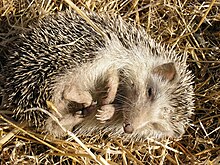North African hedgehog
| North African hedgehog | |
|---|---|
 |
|
| A North African hedgehog in the Balearic Islands | |
| Scientific classification | |
| Kingdom: | Animalia |
| Phylum: | Chordata |
| Class: | Mammalia |
| Order: | Eulipotyphla |
| Family: | Erinaceidae |
| Genus: | Atelerix |
| Species: | A. algirus |
| Binomial name | |
|
Atelerix algirus (Lereboullet, 1842) |
|
 |
|
| North African hedgehog range | |
The North African hedgehog (Atelerix algirus), or Algerian hedgehog, is a species of mammal in the family Erinaceidae. It is found in Algeria, France, Libya, Malta, Morocco, Spain, and Tunisia. Little is known about this species of hedgehog, even though the most common breed of domesticated hedgehogs is a result of crossing a four-toed hedgehog with a North African hedgehog. Because this species of hedgehog is native to Africa, it has been suggested that it was introduced by humans to the other countries where it is now found, including France and Spain (including the Canary Islands). Of the four African species of hedgehogs, the North African hedgehog is the only one of these hedgehogs that can be found outside the continent of Africa. Because the North African hedgehog has such a wide habitat range and has a seemingly stable population, both in the wild and in the domesticated capacity, it does not appear to be at risk at this time.
The North African hedgehog closely resembles the European hedgehog but there are several distinct differences between the two species. The North African hedgehog tends to be smaller than its European counterpart, measuring anywhere from 200 to 250mm long. However it is larger than the other African species of hedgehogs and has a longer snout and longer legs, making it a faster runner. Its face is light in colour, usually appearing to be white, and the legs and head are brown. The underbelly of this animal can vary in colour and is often either brown or white. Its ears are highly visible on the head of the animal and are large. The body is covered in soft spines, which are mostly white with darker banding. It is most distinguishable from physically similar relatives by the lack of spines on the crown of the head, meaning a lack of the widow's peak.
...
Wikipedia

